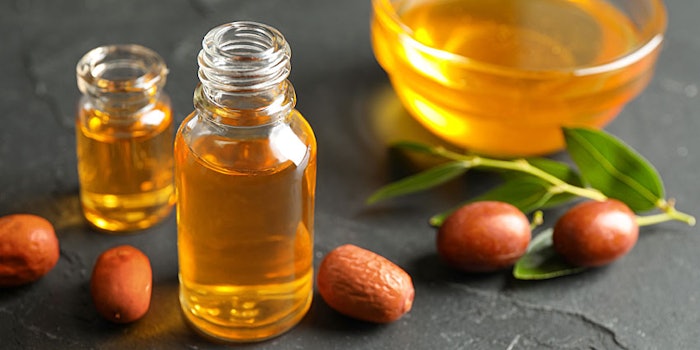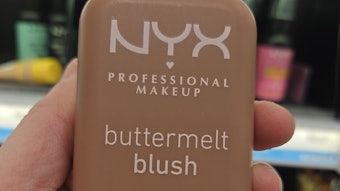
Hydrolyzed jojoba esters are derived from jojoba oil, a unique natural oil expressed from the seed of the jojoba plant. Jojoba oil (INCI: Simmondsia Chinensis (Jojoba) Seed Oil) is unlike other “fixed,” i.e. botanically derived, oils in that it is a true wax ester, in contrast to the triglyceride oils often found in the seeds of other botanical species. Jojoba oil primarily consists of straight chain monoesters of C20 and C22 alcohols and fatty acids with one point of unsaturation on each side of the ester linkage.1 It is the only known botanical wax ester that remains liquid at room temperature. In addition, its chemical structure is similar to the large wax ester component of human skin sebum, making jojoba oil well-suited to augment skin moisturization and barrier repair.
Similarly, hydrolyzed jojoba esters (HJEs) also exhibit unique moisturization and substantive properties in cosmetic and personal care formulations, as will be shown. HJEs are the partial saponification product of jojoba oil, whereby the ester bond linking the constituent fatty acids and alcohols is severed, thus liberating the hydrophobic fatty alcohol and creating a hydrophilic salt of the jojoba fatty acid (see Figure 1).
Two patented forms of HJEs currently exist, which will be referred to herein as H1a and H2b. H1 includes approximately 20% HJEs and 80% water, whereas H2 contains approximately 80% HJEs with 10% jojoba esters and 10% water. The H1 form was developed from the H2 form since it was found to form a gel that was easier to use and less petrolatum-like in feel. H1 has previously been shown to potentiate the moisturizing effect of glycerin in astringent and lotion formulations when used at levels ≥ 5%, compared with control formulations without H1.2
The present article is meant to explore the potential of H1 and H2 when used at low levels, i.e. ≤ 1%, to assess the capability of HJEs in potentiating the skin moisturization effect of glycerin in three distinct product categories: hand and body lotions, hand sanitizers, and nonwoven wipes. Glycerin is considered an industry standard to increase skin moisturization but generally is not aesthetically pleasing. As will be shown here, using hydrolyzed jojoba esters in conjunction with glycerin can reduce the amount of glycerin required within a formula without reducing skin moisturization.
Methods
The clinical studies described here were conducted in a controlled environment, at approximately 20–22°C with a relative humidity of less than 50%. Each study included a wash-out period of two to three days prior to initiation of the study during which the participants used a specified soapc for cleansing their lower legs and no additional skin care products. The studies also included a 30-min equilibration period before application of the test formulas. Corneometer measurementsd were carried out in triplicate. All clinical studies were approved by an independent institutional review board and each participant signed an informed consent form before participating in the study.
Hand and Body Lotions
One of the largest skin care product categories is the hand and body lotion category. There are hundreds of finished products on the market containing ingredients purported to provide skin moisture. Traditional ingredients include glycerin, petrolatum and silicones. However, formulators as well as consumers are seeking new approaches to deliver such benefits; in response, H1 is proposed as a natural alternative or supplement to synthetic ingredients currently used in moisturizers.
A clinical study was conducted involving 10 healthy female participants with dry skin on their lower legs. The objective was to determine the optimal ratio of H1a to glycerin to provide maximum skin moisturization, compared with the control (without H1) over time. One application of each test formula (see Formula 1) was applied to the appropriate test site on the lower legs of each participant and corneometer measurements were taken every hour for eight hours.
Results: Results showed that when H1a was used between a ratio of 1:7 and 1:10 with glycerin, maximum skin moisturization was achieved, over the control. In all cases, the test formula significantly outperformed (p < 0.05) the test vehicle, demonstrating that H1a can increase and extend skin moisturization within a lotion containing glycerin, reducing the amount glycerin, with its inherent tackiness, required. Figure 2 shows the percent increase in moisturization over eight hours.
Alcoholic Hand Sanitizers
Another important finished product category is hand sanitizers. The World Health Organization recommends the use of hydro-alcoholic hand sanitizers to help prevent the spread of infectious diseases;3 however, chronic use of hand sanitizers can dry out the skin. To overcome this drying effect, conventional hand sanitizers often include ingredients such as glycerin or aloe vera to reduce dryness, and since H1 was shown to potentiate the effect of glycerin in a lotion formulation, the authors evaluated how the ingredient worked in a hydro-alcoholic environment.
A clinical study was performed with nine healthy female participants having dry skin on their lower legs. Two formulas containing 1.0% glycerin with and without 1.0% H1 (see Formula 2) were tested and compared with a currently marketed product. Each participant received five applications of each test formula in 25 min. In addition, corneometer measurements were taken at 10 min following the last application and every 30 min thereafter for up to 4 hr.
Results: Even in a formula containing ethanol, H1 produced an increase in skin moisturization—42% over the baseline. In addition, it significantly outperformed (p < 0.05) the vehicle, which contained 1.0% glycerin but no H1. Further, the test formula including 1% H1 also maintained an increased level of moisturization over 4 hr (see Figure 3).
This data demonstrates the effectiveness of H1 in a hydro-alcoholic hand sanitizer containing a small amount of glycerin; it also suggests the ingredient could be incorporated into formulas where only a small amount of glycerin is required to increase the moisturizing benefits of the product.
Nonwoven Wipes
The wipe category is relatively new and has grown substantially in the last few years. Both hydro-alcoholic and non-alcohol-based wipes often are used to sanitize the hands and body. The solutions used to make these wipes contain either large amounts of alcohol, as prescribed by the FDA monograph, or an antibacterial agent such as benzethonium chloride. Both of these materials dry the skin, thus wipe formulas often incorporate glycerin as well to help moisturize the skin.
A clinical study was performed with 12 healthy female participants having dry skin on their lower legs. The object of the study was to determine the moisturization potential of a hydroalcoholic nonwoven wipe containing HJEs compared with the same formula not containing HJEs. In this study, either 1% H1 or 0.2% H2, along with 1% glycerin, were evaluated. Nonwoven wipes were soaked in each of the test formulas and one application of each wipe was applied to each participant by rubbing the designated test site. Skin moisturization measurements were taken by corneometer every 15 min for 2 hr.
Results: The vehicle alone, which included 1% glycerin, showed a maximum increase of 3% over the baseline. However, the test formulas containing HJEs significantly increased skin moisturization—up to 35% over the baseline (p < 0.05) compared with the vehicle alone (see Formula 3). Therefore, even a small amount (≤ 1%) of H1 or H2 was shown to produce significant increases in skin moisture when incorporated into a hydro-alcoholic nonwoven wipe. Figure 4 shows the percent increase in moisturization over 2 hr.
Another clinical study was performed with 12 healthy female participants having dry skin on their lower legs. The objective of the study was to determine the moisturization potential of a non-alcohol-based nonwoven wipe containing 0.5% H1 or 0.1% H2 along with 1% glycerin, compared with the same formula without HJEs. The vehicle (see Formula 4) was produced to mimic a current market leader’s ingredient disclosure. Nonwoven wipes were again soaked in each of the test formulas and one application of each wipe was applied to each participant by rubbing the designated test site. Skin moisturization was then measured via corneometer every 30 min for 4 hr.
Results: A maximum 47% increase in skin moisturization by the test formula containing HJEs was observed, compared with the baseline showing a maximum increase of 19% (p < 0.05 between test formulas). In addition, moisturization was maintained over 4 hr and this extended moisturization was not observed with the vehicle (see Figure 5).
Proposed Mechanism of Action
The alcohols and salts of the fatty acids of HJEs generally orient themselves in an orderly, anisotropic geometry at room temperature (see Figure 6). When glycerin, shown here by an arrow, is added to the system, the HJEs break free of the highly ordered geometry, thereby trapping glycerin (see Figures 7, 8 and 9). Accordingly, glycerin molecules are entrained when HJEs form a film on the skin, thereby increasing the bio-available hydration potential of glycerin.
Formulating with HJEs
Hydrolyzed jojoba esters are versatile ingredients that can be formulated into various product categories, including both rinse-off and leave-on types. H1 is soluble in glycerin, isopropyl alcohol, polysorbate 20 and ethanol, whereas H2 is soluble in isopropyl jojobate, propylene glycol, isopropyl alcohol, oleyl alcohol and ethanol. HJEs can be added to these vehicle ingredients and placed within a formulation in the appropriate phase as dictated by the vehicle ingredient.
Formulators should note that neat HJEs have a pH range of 9–11 but are stable down to a formulation pH of about 3. This unique property allows the formulator to neutralize polymeric systems to form a stable gel. HJEs can also neutralize many existing carbomers. Like other jojoba-derived emollients, HJEs are stable against oxidation, which can help to extend the shelf life of a finished product.4 HJEs also have demonstrated fragrance fixative properties and are known to improve the ability of quaternium compounds.2
Conclusions
H1 and H2 HJEs are botanically derived raw materials that have been shown to potentiate the hygroscopic effect of glycerin. The data presented here demonstrates the skin benefit of these natural materials in distinct product categories including body washes, lotions, hand sanitizers and nonwoven wipes. The proposed mechanism of action suggests HJEs trap glycerin molecules at the skin’s surface. They therefore not only increase moisturization, but also are able to extend moisturization for a greater amount of time, even at relatively low use levels. One could further speculate that the HJEs could trap other small molecules on the surface of the skin, thereby enhancing product efficacy and even possibly decreasing the absorption of actives through the skin. Candidates that will be tested at a later date include organic sunscreen actives and preservatives.
References
Send e-mail to
.
1. J Wisniak, Jojoba oil, in The Chemistry and Technology of Jojoba Oil, ch 1, Champaign, IL: American Oil Chemists’ Society (1987) pp 1
2. M Cummings, Built to Last, Soap, Perfumery & Cosmetics 42–45 (Nov 2001)
3. WHO Guidelines on Hand Hygiene in Health Care, World Health Organization (2009)
4. JH Brown, DJG Arquette, R Kleiman and S Koritala, Oxidative stability of botanical emollients, Cosm & Toil 112 7 87–98 (Jul 1997)
Lab Practical: Using HJEs
- H1 is soluble in glycerin, isopropyl alcohol, polysorbate 20 and ethanol.
- H2 is soluble in isopropyl jojobate, propylene glycol, isopropyl alcohol, oleyl alcohol and ethanol.
- HJEs have a pH range of 9–11 but are stable down to a pH of about 3.
- HJEs can neutralize existing carbomers.
- HJEs also have demonstrated fragrance fixative properties and can improve the ability of quaternium compounds










